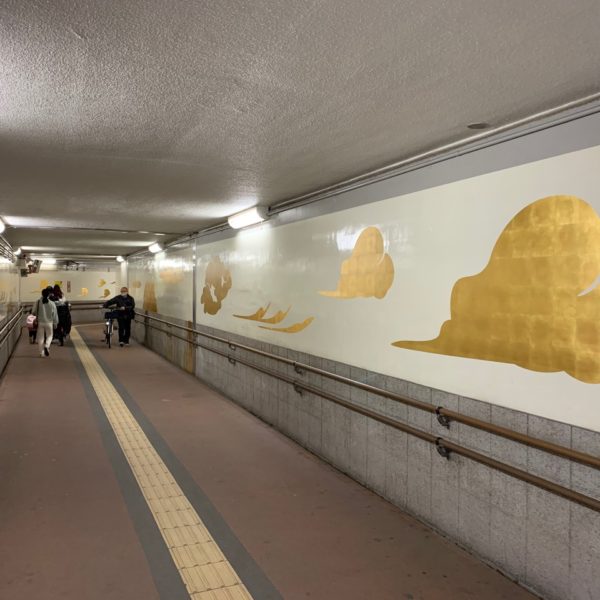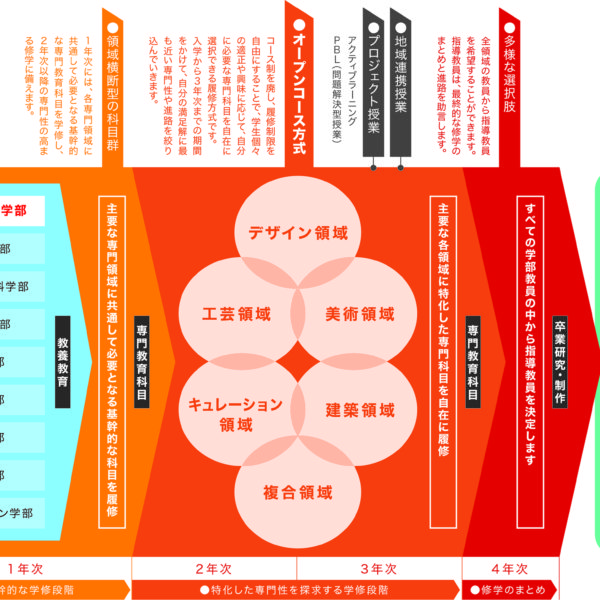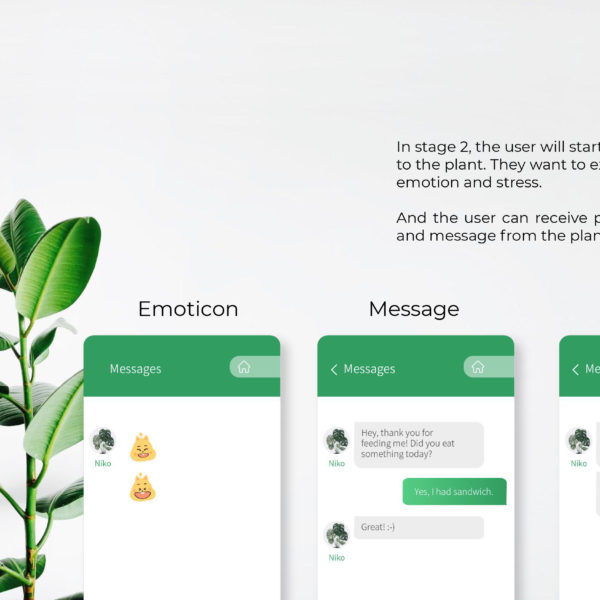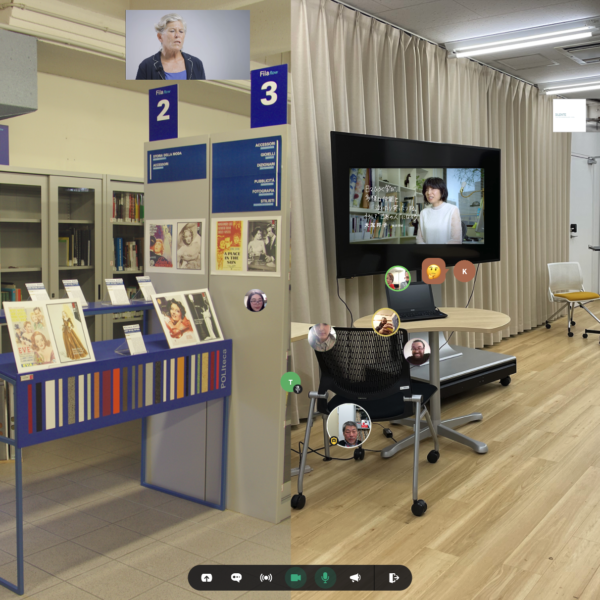CategoryThe New Normal: A New Relationship between Society and Design

Thinking about Design on the Southern Island
At first glance, Okinawa’s location, the most remote from the center of Japan, may seem disadvantageous as an environment for studying design. However, we consider our unique subtropical climate, the only one of its kind in Japan, to be a geographical advantage and actively conduct research to find clues to solving social problems. For example, while learning the basics and applications of design extensively, we may include materials rooted in the local community as part of the curriculum to develop human resources to contribute to the local community. The “Design Planning” and “Development of Local Specialties” at the end of the second year are one such initiative. The students research […]
Read More2022.3.29

Efforts to Create a City as a Place for Experimental Presentations
The area around Yokogawa Station, the second station west of Hiroshima Station on the Sanyo Main Line, is home to many students at Hiroshima City University because of its easy access to the university. The area used to be one of Hiroshima’s leading manufacturing towns and is very proactive in its understanding of art and design. As a result of the many supportive activities for young artists in the past, we have decided to design the interior of the residence (AIR Hiroshima) for artists to stay for a short period of time to create and present their works and to work on the graphic work for the north-south free passageway […]
Read More2022.3.29

Research Assignment on Design Elements in the Local City
Onomichi City, where our university is located, is a relatively small local city with a population of about 130,000. In the past, Onomichi was a hub of cultural, material, and human exchange where Kitamae ships called at ports. Since the modern era, it has developed as a key location for maritime affairs in the Seto Inland Sea. What is the design that characterizes the townscape of such a small local city? The elements that shape the region image in a metropolitan area change rapidly in response to the changes of the times, but those in a local city are relatively gradual and have a retro feel that seems to have […]
Read More2022.3.29

The Relationship between Region and Design
Our school considers regional characteristics and design education to be an essential relationship today and has prepared a program of regional cooperation subjects and projects. In particular, the Ministry of Education, Culture, Sports, Science and Technology’s “Project for Universities as Drivers of Regional Revitalization through New Human Resources Education Programs” focuses on the development of regional human resources. By developing a curriculum of design management as a common subject for all departments in the Faculty of Design, we are fostering not only design skills but also fostering design thinking ability as a management resource and developing human resources who can play an active role in the local community. The […]
Read More2022.3.29

Archiving the Enriching Exchange Programs
30th Anniversary of Exchange Program with RCA The Kyoto City University of Arts has concluded exchange programs and agreements with 19 universities around the world. The Faculty of Fine Arts and the Graduate School of Arts has concluded agreements with 11 universities in 9 countries in Europe, North America, and Asia, including the Royal College of Art (London, UK), Politecnico di Milano (Milan, Italy), Ecole Nationale Supérieure des Beaux-Arts (Paris, France), Aalto University (Helsinki, Finland), and NSCAD University (Halifax, Canada) to offer exchange programs. In particular, we began an agreement with the Royal College of Art (RCA) in 1989, which marked the beginning of our exchange program, and we continue […]
Read More2022.3.29

Under the theme of “Creativity born from cross-disciplinary approaches”, the KYOTO Design Lab at Kyoto Institute of Technology (KYOTO) holds the “ME310/SUGAR” program every year. It is a nine-month program in which participants work together with overseas universities using design thinking methods to tackle various issues provided by global companies. The “ME310/SUGAR” is an educational network in which the “ME310” program from Stanford University has spread to over 20 universities around the world as the “SUGAR Network” and Kyoto Institute of Technology is the only research and educational institution in Japan to participate in this network. On July 9, 2021, Kyoto Design Thinking EXPO 2021 was held as an opportunity […]
Read More2022.3.29

The Graduate School of Design and Architecture offered high school students the opportunity to experience video production as part of Nagoya City University’s “Grade Skip Challenge,” a high school-university collaboration project. This project is a summer workshop in which high school students receive guidance from teachers and university students on the entire process of modern video production, from story conception and scenario creation to shooting, editing, and adjusting the finished file. We are proud that we were able to provide more knowledge and wisdom to the high school students than just a visit to a laboratory. They learned how to use professional equipment and witnessed a wide range of creative […]
Read More2022.3.29

Design Education and Research Activities that Contribute to Shizuoka Prefecture
As universities are expected to contribute to the local community, our university has responded to requests from local governments and companies in the prefecture for community collaboration activities that lead to design education and research. The following are the three main types of activities. (1) Commissioned from local governments in the prefecture As a public university, our university has strong ties with Shizuoka Prefecture and municipalities in the prefecture. We have many opportunities to receive various design commissions for architecture, landscape design, and graphic design. When commissioned, our graduate students play a central role in designing and producing the following projects, serving as practical education. 《Main examples》 Shizuoka Prefecture, […]
Read More2022.3.29

"Saihate", Art Festival Participation Project
The first Oku-Noto Triennale was held in 2017 in Suzu, the farthest point at the tip of the Noto Peninsula, attracting over 70,000 visitors. At Kanazawa College of Art, a group of students and faculty members from different majors and grades formed the Kanazawa College of Art, Art Project Team, Suzupro, to create an installation work in a large old house in Suzu City and to engage with the local community through various activities such as planning in collaboration with the shopping district. The second Oku-Noto Triennale was scheduled for the fall of 2020. However, due to the impact of the new coronavirus, it was postponed to the fall of […]
Read More2022.3.29

Towards Fully Integrated Education Freed from the Course System
For the reasons mentioned in the previous section, the School of Art and Design at the University of Toyama has long been experimenting with integrated education to cross various educational fields related to art and culture by designing a system that facilitates the participation of students with different backgrounds, enriching core subjects commonly required for specialized fields, and a system in which students can choose a supervisor from all the faculty members for graduation research and production. However, it could not be denied that the course system, which is a typical (i.e., normal) university education system, and the sense of mutual non-interference in other specialized fields that the system inevitably […]
Read More2022.3.29

Social Cooperation During Coronavirus Pandemic
Our university has established the Center for Regional Collaboration as a contact point for regional and social collaboration. We received requests from local companies and municipalities to the university for solutions to various problems that are divided into three categories: 1) “Design Research and Development Commissioned Projects”, in which faculty members take the initiative in handling their own research and design projects; 2) “Regional Collaboration Exercises”, for undergraduate students as class projects; and 3) “Regional Special Project Exercises”, for graduate students. The “Regional Collaboration Exercises” was launched in 2014 and is open to students in their second year of undergraduate studies or above who wish to participate. The content of […]
Read More2022.3.29

How to Share Inconveniences Online?
Chiba University’s Design Course stopped sending and receiving students after the workshop we co-hosted with Seoul National University in January 2020. Some people were optimistic that the coronavirus pandemic would be over in about half a year and that we would resume the same activities as last year. In the discussions with faculty members from other universities, we were motivated to turn the situation into an opportunity. Hence, in June, we decided to hold an online workshop in September. Since then, we have held several international online workshops despite the ongoing coronavirus pandemic. As an example, we would like to introduce the online workshop conducted by the “Plant Environment Innovation […]
Read More2022.3.29

International Exchanges During COVID-19
The University of Tsukuba’s Bachelor’s Program in Design (DPD) has implemented an educational strategy promotion project for the fiscal year 2020: “Building a Foundation for International Research and Education Collaboration in Creativity (IRACI) and Realizing an International Joint Degree Program”. The following three objectives are the strategic research and education program (IRACI: International Research Alliance for Creativity and Innovation) for learning and applying creativity. 1. To conduct an International Creativity Research Festival to build an international collaborative organization for creativity research and to realize a double degree/joint degree program. 2. To introduce a VR conferencing system that allows many people to gather virtually in one place, share their experiences, and […]
Read More2022.3.29

The Search for a Sustainable Regional Cycle Linking Education and Industry
Based on the founding principle of “leveraging and developing Akita’s traditions and culture”, the University has been developing local brands and promoting local industries in Akita Prefecture through practical projects. From the fiscal year 2019, we have conducted “ORAe Project”, aiming to build a new collaboration system between the University and industry that goes beyond individual projects. This Project is a collective of woodworking businesses scattered throughout Akita Prefecture. It aims to be a platform that contributes to the development of the woodworking industry and to the nurturing of its future leaders. This Project will connect veteran and young businesses that have had little interaction with each other, and promote […]
Read More2022.3.29

WHEE Project: A Fun Future Created With 5G, AR and Wheelchairs
Under the initiative of the Tokyo Metropolitan Government, the Tokyo Metropolitan University is focusing on research and development related to the local 5G environment from 2020. Our department is leading the “WHEE Project”, a project to develop and provide an outdoor activity support system for wheelchair users, which aims to support independent activities in a fun way with a wheelchair device that has a built-in camera and sensor and AR contents. Professor Kumiko Kushiyama is actively promoting this project. Under the title of “Social Implementation of AI Wheelchair System to Support Fun Independent Movement with AR Games”, we develop assistive technologies and content to help the elderly and people with […]
Read More2022.1.19
